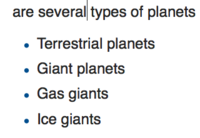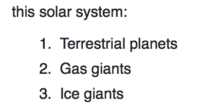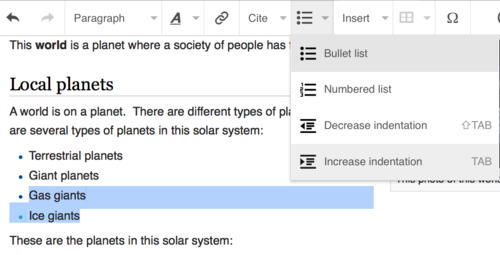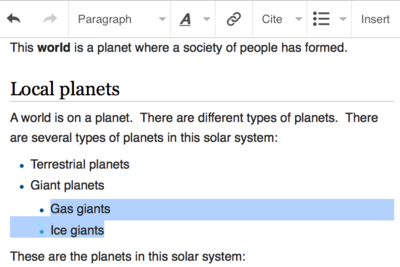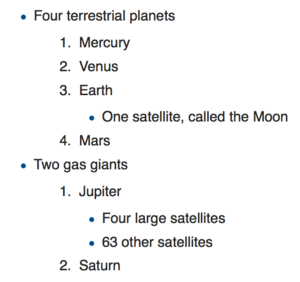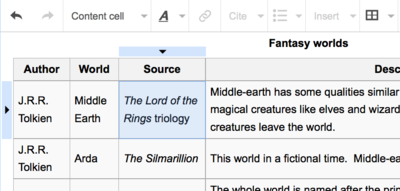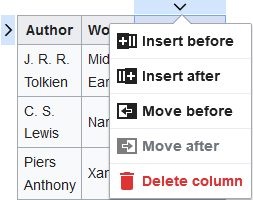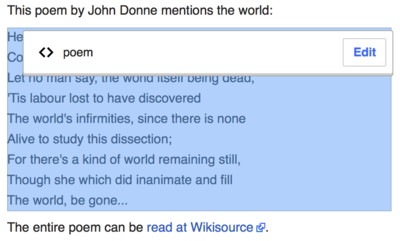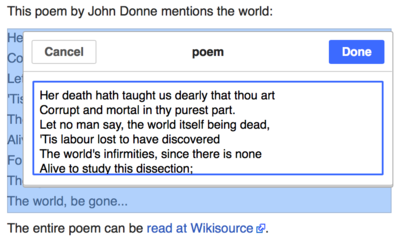مَدَتھ:ظٲہِر اؠڈِٹ خانہٕ
<languages />
| اَگر تُہؠ چھِو یَژھان ظٲہِر اؠڈِٹ خانہٕ، کانٛہہ مَضموٗن اؠڈِٹ کَرنہٕ وَرٲے ٹؠسٹ کَرُن، یَتھ صَفَس پؠٹھ ہیٚکِو تُہؠ ٹؠسٹ کٔرِتھ. تُہؠ چھُنہٕ کھاتہٕ ضۆروٗری ظٲہِر اؠڈِٹ خانہٕ سٲتؠ اؠڈِٹ کَرنہٕ خٲطرٕ. |
ظٲہِر اؠڈِٹ خانہٕ اِبتِدا
اِبتِدا: ظٲہِر اؠڈِٹ خانہٕ اَوزار شَلف
| اَوزار شَلف چھُ سِکریٖنَس پؠٹھٕ آسان. اَتھ مَنٛز چھِ یِم اَوزار آسان: | |
| "رَد کٔرِو" تہٕ "بَحال کٕرو" تَبدیٖلی یِم تُہؠ اَنجام دِتمِتِس آسَن. | |
 |
سَرنامہٕ بۄن کُن .ؠنِو: اَتھ مَنٛز چھِ پَرےگرٛافُک طَرٕز بَدلاونہٕ یِوان . طَرٕز بَدلاونہٕ خٲطرٕ گَژھہِ گۄڈٕ پَرےگرٛاف مُنتَخٕب کَرنہٕ یُن. حِصہٕ سَرنامہٕ چھِ یَمہٕ سٲتؠ "سَرنامہٕ",تہٕ لۄکٕٹؠ سَرنامہٕ یَمہٕ سٲتؠ "لوکُٹ سَرنامہٕ 1", "لوکُٹ سَرنامہٕ 2", بَناونہٕ یِوان. عام مَتنُک طَرٕز چھُ "پَرےگرٛاف". |
 |
مَتَن طَرٕز: "A" بَٹُن دَباونہٕ سٲتؠ چھُ اَکھ مؠنِو اِظہار گَژھان.
اَگر تُہؠ چھِو نہٕ مَتَن مُنتَخٕب کۄرمُت تہٕ تُہؠ دَبٲوِو "A"، اَمہِ سٟتؠ گَژھہِ دَرٕج ڈَبہٕ اِظہار، اَمہِ مَنٛز کانٛہہ تہِ طَرٕز مُنتَخٕب کَرنہٕ سٲتؠ گَژھہِ نہٕ مَتَن تَبدیٖل بٕلکہِ یُس مَتَن تُہؠ وَنہٕ لیٚکھِو، تَتھ روزِ یہِ طَرٕز. |
 |
لِنک بَناونُک اَوزار: چین نِشان چھُ لِنک بَناونُک اَوزار. مَتَن مُنتَخٕب کٔرِتھ تہٕ یہِ بَٹُن دَبٲوِتھ چھُ اَکھ لِنک دَرٕج ڈَبہٕ اِظہار گَژھان. |
 |
حَوالہٕ مؠنِو: "حَوالہٕ" مؠنِو چھُ سطٕر حَوالہٕ بَناونَس مَنٛز اِستِمال کَرنہٕ یِوان. پرٛتھ کُنہِ مَنصوبَس مَنٛز چھُ یہِ اِستِمال کَرنہٕ یِوان.
(حَوالہٕ مُتلِق مُقٲمی ہؠدایَتھ چھِ مُقٲمی وِکی فرما:Ll پؠٹھ موجوٗد آسَن) |
 |
حَوالہٕ بَٹُن: اَگر فرما:Ll آسہِ ییٚلہِ تُہُنٛدِس مَنصوبَس پؠٹھ، تیٚلہِ وُچھِو تُہؠ حَوالہٕ مؠنِو بَدلہٕ حَوالہٕ بَتُن. (یہِ وُچھنہٕ خٲطرٕ زِ یہِ چھس یَلہٕ، وُچھِو "Special:Version" صَفہٕ پَنِس مُقٲمی وِکی پؠٹھ تہٕ یَتھ جاے سایٹایِڈ چھُ یَلہٕ)
سایٹایِڈ چھُ حَوالہٕ فرما مَنٛز مولوٗماتھ خود مۄختار طَور دَرٕج کَرَن. |
 |
فِہرِست تہٕ اَند: "نۄقطہٕ دار فِہرِست" بَٹُن چھُ نۄقطہٕ دار فِہرِست بَناونہٕ خٲطرٕ اِستِمال گَژھان تہٕ "نَمبَر دار فِہرِست" بَٹُن چھُ نَمبَر دار فِہرِست بَناونہٕ خٲطرٕ اِستِمال گَژھان. آخری زٕ چھِ جاے تھاونہٕ خٲطرٕ اِستِمال گَژھان. |
 |
دَرٕج: "دَرٕج" مؠنِو چھُ کیٚنٛہہ مَنصوبَن مَنٛز مُختَلِف. بۄنہٕ کَنہِ چھِ اَمیِک تَمام اِختِیار ہٲوِتھ.
|
| خاص اَچھَر اِستِمال: "خاص اَچھَر" نِشان (Ω) چھُ "دَرٕج" مؠنِوَس نَکھہٕ. یہِ دَبٲوِتھ چھُ اَکھ خاص اَچھَر دَرٕج ڈَبہٕ اِظہار گَژھان. اَمہِ مَنٛز کانٛہہ اَچھَر دَبأوِتھ ہیٚکِو تُہؠ سُہ اِستِمال کٔرِتھ. (یہِ فِہرِست چھِ مُقٲمی طور بَدلاونہٕ یِوان. وُچھِو فرما:Ll) | |
| اؠڈِٹ اِطلاع بَٹُن چھُ صَفٕچ اِطلاع ہاوان. | |
 |
صَفہٕ یَختِیار مؠنِو چھُ "بَدلاو کٔرِو شایع" تہٕ "اؠڈِٹ خانہٕ بَدلٲوِو" بَٹنَن کھووُرِ طَرفہٕ. اَتھ مؠنِوَس مَنٛز چھُ اَکھ بَٹُن "یَختِیار" دَرٕج ڈَبہٕ اِظہار کَرنہٕ خٲطرٕ، یَتھ مَنٛز یِم بَٹَن چھُ آسان.
یَختِیار دَرٕج ڈَبٕک بَٹَن چھِ صَفہٕ یَختِیار مینِوَس مَنٛز تہِ دٕستِیاب. بیٚیہِ، صَفہٕ یَختِیار مینِوَس مَنٛز چھِ کھووُرِ پؠٹھ دٔچھُن وُچھِو یا دٔچھُنہِ پؠٹھ کھووُر وُچھِو تہٕ تَلاش تہٕ تَبدیٖل آسان، یِم اَکھ ڈَبہٕ اِظہار کَران چھِ، اَتھ مَنٛز چھِ کانٛہہ لَفٕظ دَرٕج کٔرِتھ سہُ تَلاش تہٕ بَدلاونہٕ یِوان، اَمہِ عَلاوہ تہِ چھِ اَتھ مَنٛز یَختِیار آسان. |
| اؠڈِٹ خانہٕ بَدلٲوِو بَٹُن چھُ بَدلاو کٔرِو شایع بَٹنَس نَکھہٕ. یہِ چھُ کوڈ اؠڈِٹ خانَس پؠٹھ واتٕنَس لَگان. | |
تَبدیٖلی شایع کَرٕنؠ
لِنکہٕ اؠڈِٹ کَرٕنؠ
 |
لِنکہٕ چھِ "لِنک" بَٹنہٕ سٲتؠ بَناونہٕ یِوان یا کی بوڈ شارٹکَٹ Ctrl+K(یا ⌘ Command+K میک بُک).
اَگر تُہؠ مَتَن مُنتَخٕب کٔرِتھ "لِنک" بَٹُن دَبٲوِو، یہِ مَتَن گَژھہِ لِنک بَناونہٕ خٲطرٕ اِستِمال گَژھان.. |
 |
بَٹُن یا شارٹکَٹ اِستِمال کٔرِتھ چھُ اَکھ دَرٕج ڈَبہٕ اِظہار گَژھان یَتھ مَنٛز لِنک چھِ دَرٕج کَرنہٕ یِوان.
لِنک اَوزار چھُ اۆنٛدروٗنی لِنکہٕ تَلاش کَرنَس مَنٛز مَدَتھ کَران. لِنک دَرٕج کٔرِتھ دَبٲوِو دَرٕج بَٹُن یا "دَرٕج" بَٹُن. تُہُنٛد لِنک گَژھہِ جَلدی اِظہار، اَمہِ پَتہٕ گَژھہِ صَفہٕ شایع کَرنہٕ یُن. |
 |
باقی وؠب سایِٹَن ہٕنٛز لِنک تہِ چھِ لَگ بگ یِتھے پٲٹھؠ بَناونہٕ یِوان؛
"بیٖروٗنی ویب سایٹ" بَٹُن دَبٲوِو لِنک دَرٕج ڈَبہٕ مَنٛز، تہٕ کٔرِو یو آر ایل دَرٕج ڈَبَس مَنٛز. |
 |
بیٖروٗنی لِنکہٕ ناو وَرٲے چھِ یِتھ پٲٹھؠ آسَن:
[1]. تُہؠ ہیٚکِو یِم دَرٕج کٔرِتھ کٔرسَر لَفظٕ نِش تھوڈا دور تھٲوِتھ (مِثال، اَکھ جاے) لِنک اَوزار کٔرِو اِظہار بَٹَن یا شارٹکَٹ دَبٲوِتھ. یو آر ایل ڈَبَس مَنٛز دَرٕج کٔرِتھ دَبٲوِو "دَرٕج" بَٹُن لِنک دَرٕج کَرنہٕ خٲطرٕ. |
 |
To change or remove an existing link, press within the text for that link, then press the "لِنک" icon that appears near it. The dialog will appear, for editing. You can also get to the dialog with the Ctrl+K keyboard shortcut. When a link is selected, it appears as blue framed.
In the link editing dialog, you can then change where the link goes. You can also remove the link entirely by pressing the "ہَٹٲوِو" button in the upper right corner of the dialog. You can also open the link's target in another window by pressing on the copy of the link in the dialog box. (You might want do this to check if an external link is valid.) If you want to exit the link label (the text displayed as a link) or continue to write after this link, you can press →:
To edit the link label of an existing link, press within the link label and type the new one. But if you want to replace the entire label, please note:
|
حَوالہٕ اؠڈِٹ
Determining which system is in place | |
| Your wiki may use one of three footnote systems. The one shown on the right is the simplest system, where the "حَوالہٕ" menu does not include any citation templates. If your wiki uses this system, then everything you need to know about footnotes is on this page. |  |
| The second system has the same type of "حَوالہٕ" menu, but with several popular citation templates set up for quick access. If your wiki uses this system, then you will find more details at فرما:Ll |  |
 | |
| In the third system, you again start by pressing the حَوالہٕ button. Then a dialog box opens, which includes an automatic citation process using the citoid service. If your wiki uses this system, you will find more details at فرما:Ll |  |
موجوٗدٕ حَوالہٕ اؠڈِٹ کَرُن | |
| To edit an existing reference, press on it where it appears in the text (usually as a bracketed number). You will see either a "حَوالہٕ" icon (bookmark) or an icon (and name) for the template that was used to create this reference. In either case, pressing on the "تَبدیٖل" button will open a dialog where you can edit the reference. |  |
| For the "حَوالہٕ" icon, pressing "تَبدیٖل" opens the reference dialog. To start changing the reference information, press on it.
Many wikis use templates to format references. If a template is used in your reference, then when you move your pointer over the reference information, all the information in that field will be highlighted. If a template was used and you press on the reference information, then the فرما icon (puzzle piece) will appear with some information. Press on the "تَبدیٖل" button to edit the content of the template in the template mini-editor dialog. |
 |
| If what appears when you press on a reference is an icon for a standard template for citations (an example is at right), then pressing "تَبدیٖل" will open the template mini-editor dialog. |  |
| Inside the template mini-editor, you can add or remove types of information or change current content. Only fields (template parameters) that have content will show, initially. To add fields, press on "اِضافہٕ" at the bottom of the mini-editor. |  |
| Press on "تَبدیٖلی کٔرِو نٲفِذ" when you are done. |  |
Re-using an existing reference | |
| If the page already contains a citation that applies to the text you want to source, then you can choose to re-use that existing citation.
To re-use an existing reference, place your cursor in the body of the text where you want to add a new reference (number) for that citation. Then press on the "بیٚیِہ اِستِمال" item from the "حَوالہٕ" menu. (Note: If your wiki has the third footnote system described above, you'll see a "بیٚیِہ اِستِمال" tab, in a dialog, instead of a "بیٚیِہ اِستِمال" item on the "حَوالہٕ" menu.) |
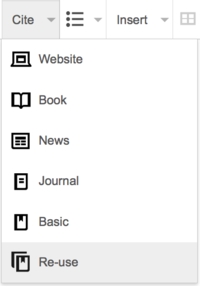 |
| In the حَوالہٕ dialog, look at the list for the reference you want to reuse, and select it. If there are many references, you can use the search box (labeled "Search within current citations") to list only those references that include certain text. |  |
Adding a new reference | |
| To add a citation using the "حَوالہٕ" menu, place your cursor where you want to add it in the text. Then select the appropriate citation type in the menu. |  |
Using the "Basic" citation | |
| Shown here is what you will see if you select the basic references item. In the Reference editor, you can add your citation, including formatting.
You can make the reference belong to a given group, although normally this is left blank. (This option is used to display groups of references with the "حَوالہٕ فِہرِست" tool.) |
 |
| In the Reference dialog, if you want to include a citation template, or any other template, in your new reference, press the فرما icon (puzzle piece) in the "دَرٕج" toolbar menu within the Reference editor. |  |
| Then, look for the template you want to use, add it and edit it as you would any other template. (See the Editing templates section, below, if you need more information about templates.)
After you are done editing your new template, press on "تَبدیٖلی کٔرِو نٲفِذ" to return to the Reference editor, and "تَبدیٖلی کٔرِو نٲفِذ" again to return to the page you are editing. |
 |
| If there isn't already a list of references on the page (for example, if you are adding the first reference for the page), you need to specify where the list of references, and their text, will be displayed to the reader.
Place the cursor where you want to display the references list (usually at the bottom of the page), open the "دَرٕج" menu and press the "حَوالہٕ فِہرِست" icon (three books). |
 |
| If you are using several groups of references, which is relatively rare, you can specify the group in this dialog. Only the references that belong to that group will be displayed on the page at the location where you are placing the group.
The final step in the References list dialog is to press "دَرج کَرُن". |
 |
Using standard cite templates | |
| Your local wiki may have added extra citation templates to the "حَوالہٕ" menu. If so, you have quick access to the most-used citation templates for your wiki. (Instructions for adding extra citation templates to your local wiki are available at فرما:Ll.) |  |
| Pressing on a template icon such as "Cite book" will take you into the template mini-editor for that template. Important information fields may be marked with an asterisk. While the most common fields will be shown, not all of them are required. |  |
| To add more parameters, scroll down in the template mini-editor and press on the "اِضافہٕ" option.
Press on "دَرج کَرُن" when you are done. |
 |
Editing images and other media files
Uploading images
Editing media galleries
Editing templates
The powerful MediaWiki template system lets you insert dynamic content, text from other pages, and much more. For a detailed explanation and examples, see the Templates help page.
In the VisualEditor you can search for a relevant template, add an invocation or transclusion on the page you’re editing and, if needed, add custom content using parameters.
Insert new template
| To add a template to a page, place your cursor at the position on the page where you want the template to be inserted. Then open the دَرٕج menu and select " |
 |
| Find the template you want to insert by typing either its name or a relevant keyword. Results containing the search term in either the name or description will display in a dropdown. This should help you find a relevant template, even if you don’t know its exact name.
If you’re having trouble finding the kind of template you want by using keywords, you can look on other wiki pages with similar content and view or edit the page source to see which templates are in use. When you find the desired template’s name, you can type it into this field to insert it here. |
 |
| You can also edit a template that’s already on a page. When you select the template you want to edit, it turns blue, and a box appears displaying " |
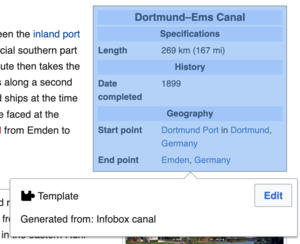 |
| Some templates are not visible to someone reading a page. In the visual editor, such hidden templates are still shown so that you can click and edit or delete them. The name of the template will be shown next to the puzzle icon and both will be grayed out. |  |
|
Template parameters | |
| You’ll see this dialog box when you’re adding a new template or editing one already in place. What you see in the box depends on whether the template in question contains فرما:Ll, helpful metadata added by other editors to make it easier to edit templates in the Visual Editor.
When a template contains TemplateData, the VisualEditor can use it to present annotated fields for you to fill in.
|
 |
| You can disable any optional parameter (which have blue checkboxes on the left side). If a parameter’s checkbox is grayed out and not clickable, the template requires that parameter, so it can’t be disabled.
When you insert a new template, you may find that some optional parameters are pre-selected. That means the author(s) of the template recommends the use of those parameters. It’s best to review all parameters that will be used in a template to ensure you understand their use. Clicking an unchecked parameter adds it to the template. Clicking a parameter that’s already been added takes you to the parameter’s input field. Some template parameters will show as “deprecated”. Don’t use deprecated parameters when inserting a template; they’re only visible to you because those parameters are in use on older pages where this template was included. |
 |
|
Adding undocumented parameters | |
| If you’re inserting or editing a template whose author hasn’t laid out its parameters in TemplateData, it has what we call “undocumented” or “unnamed parameters”. In these cases, you should consult the page for the template itself. There you can learn how to correctly employ and work with all of the template’s parameters. This includes learning the exact names of the parameters as written by the template author.
If you find in the documentation that the template expects parameters without names, fill in numbers as placeholders for the parameter names using the undocumented parameter input, then add text to the values you want to provide as you normally would. مِثال:
If you accidentally include nonexistent, misspelled or erroneous parameters, the values you enter for those parameters won’t show up on the page you’re editing. |
 |
|
خۄدکار پیرامیٖٹر | |
| In this example, the template in question lacks TemplateData but it was possible to autogenerate the parameters. This means that the undocumented parameters have already been added for you, but the names may not be easily understandable and the dialog cannot display any directions or descriptions. As a result the dialog box provides a link to the template’s documentation, which should help you deduce and fill in the template’s various parameters. |  |
|
Editing multi-part template content | |
| During editing, you may open template content consisting of multiple templates or a single template linked to some wikitext. This differs from the nested templates described below. In this case, the templates are better visualized as being stacked or connected.
This content often contains “unbalanced templates,” templates which are incomplete on their own and need to be paired with some wikitext or another template in order to function. These related pieces of template content must be created in wikitext, but can be edited in the VisualEditor. In these cases you will see a notice at the top of the dialog to signal the situation and a specialized toolbar will be visible at the bottom of the sidebar. There you can use the icon buttons to add additional templates, additional wikitext, delete elements or change their order. |
 |
Nested templates | |
| Templates can include other templates as the value for parameters. You’ll recognize it when you see a parameter whose value contains the double curly braces ( {{ }} ) denoting a template.
The VisualEditor can’t present this template within a template (a nested template) using the editor’s easy-to-use interface, so if you want to nest a template yourself, you’ll need to understand how to add the template by hand in wikitext into the appropriate parameter field. |
 |
اؠڈِٹ مُکَمَل کَرُن | |
| When you have finished editing a template, you can click "تَبدیٖلی کٔرِو نٲفِذ". Then you can preview your edit and make sure it looks the way you want and expect.
You may also see an error message, which (like the other TemplateData mentioned above) is community-provided content and may vary in usefulness. You may need to consult the template’s own documentation to get to the bottom of some errors. If you’re still having trouble, consider posting about your problem on the template’s talk page. |
 |
فرما ہَٹاوُن | |
| To remove a template in the VisualEditor, click the template box. Press the "Delete" or "Backspace" key on your keyboard. The template will disappear from the page. |  |
موبٲیِلس پؠٹھ اؠڈِٹ کَرُن | |
| When editing a template on a page using the VisualEditor on a mobile device, you’ll see that the sidebar starts out hidden. You can make it visible by pressing the “Show/hide options” button. |  |
Substituting templates | |
| When you insert a template in a wiki page, its content and appearance are reevaluated every time the page loads, based on the template code and the values of its parameters. This means if someone updates the code of a template, then every page which uses that template will also get updated when they publish.
There’s another, much less common way to use templates, though, and that’s to substitute a template. Doing this permanently includes the template content just as it appears at the moment you insert it. It will not update if the template code is later changed. Most users won’t ever need to resort to substitution. Substitution is typically only useful when you need to capture the exact appearance of one version of a template, such as when content is under development and needs evaluation. To substitute a template in the VisualEditor, insert a template using the name syntax When you’re finished, press “Insert”, which will insert the template content as you see it. |
 |
اؠڈِٹ فِہرِست
Editing tables
Editing categories
 |
To edit categories, on the "صَفہٕ یَختِیار" menu, press the "زاتھ" item. |
 |
Pressing on "زاتھ" opens a dialog that lists existing categories and allows you to add new ones, and to delete existing categories.
You also have the option of setting or changing the general (default) sorting key, which determines where the page appears when listed with other pages in the same category. For example, the default sorting key for the article "George Washington" is "Washington, George". In the category "Presidents of the United States", the article is listed under the letter "W", not the letter "G". |
 |
To add a category for a page, type the name of the category into the field "زٲژ کٔرِو شٲمِل". As you type, the visual editor will search for possible matching, existing categories. You can either select an existing category, or you can add a category that doesn't yet have its own category page. (Until that category page is created, your new category will show as a red link after you publish all your editing changes.) |
 |
To remove an existing category, press on it and press on the "ہَٹٲوِو" icon (trash can) in the dialog that opens.
Pressing on a category also allows you to specify a sorting key for that specific category. Such a sorting key overrides the default sorting key. |
 |
Press "تَبدیٖلی کٔرِو نٲفِذ" when you are done editing categories to return to the page editor. |
Editing page settings
Editing maps
 |
You can add and change maps. See فرما:Ll. |
Editing mathematical formulae
موسیٖقی ہٕنٛد نِشان اؠڈِٹ کَرٕنؠ
Editing poems and other special items
Switching between the visual and wikitext editors
کی بوڈ شارٹکَٹ
کی بوڈ شارٹکَٹ چھِ کیٚنٛہہ کامہِ جَلدی کَرنہٕ دِوان. بۄنہٕ کَنہِ چھِ کیٚنٛہہ شارٹکَٹ یِم اِستِمال کَرنہٕ چھِ یِوان:
| کَمپیوٗٹِڑ شارٹ کَٹ | عَمل | میک .ۄختَصر وَتھ |
|---|---|---|
| Ctrl+B | موٹ | ⌘ Cmd+B |
| Ctrl+I | ہول | ⌘ Cmd+I |
| Ctrl+K | لِنک کٔرِو دَرٕج | ⌘ Cmd+K |
| Ctrl+X | کٹ | ⌘ Cmd+X |
| Ctrl+C | کاپی | ⌘ Cmd+C |
| Ctrl+V | پیسٹ | ⌘ Cmd+V |
| Ctrl+Z | رَد | ⌘ Cmd+Z |
[[Category:VisualEditor{{#translation:}}|User guide]] [[Category:Help{{#translation:}}]]






















